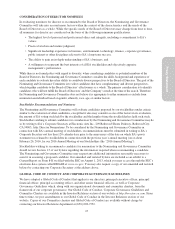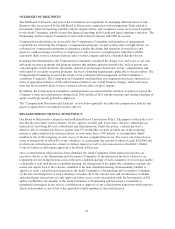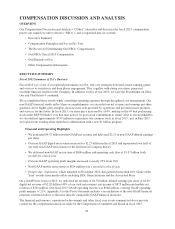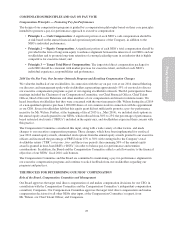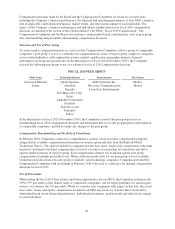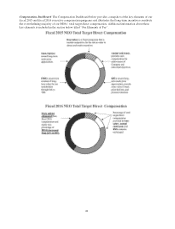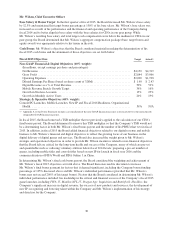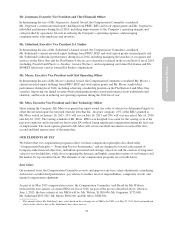Electronic Arts 2015 Annual Report Download - page 31
Download and view the complete annual report
Please find page 31 of the 2015 Electronic Arts annual report below. You can navigate through the pages in the report by either clicking on the pages listed below, or by using the keyword search tool below to find specific information within the annual report.
Proxy Statement
COMPENSATION PRINCIPLES AND SAY ON PAY VOTE
Compensation Principles — Promoting Pay-for-Performance
The design of our compensation programs is guided by a compensation philosophy based on three core principles
intended to promote a pay-for-performance approach to executive compensation:
•Principle 1 — Cash Compensation: A significant portion of each NEO’s cash compensation should be
at risk based on the annual financial and operational performance of the Company, in addition to the
NEO’s individual performance;
•Principle 2 — Equity Compensation: A significant portion of each NEO’s total compensation should be
provided in the form of long-term equity to enhance alignment between the interests of our NEOs and our
stockholders and to promote long-term retention of a strong leadership team in an industry that is highly
competitive for executive talent; and
•Principle 3 — Target Total Direct Compensation: The target total direct compensation package for
each NEO should be consistent with market practices for executive talent, and reflect each NEO’s
individual experience, responsibilities and performance.
2014 Say On Pay Vote, Our Investor Outreach Program and Resulting Compensation Changes
We value the feedback of our stockholders. In connection with the say on pay vote at our 2014 Annual Meeting,
our directors and management spoke with stockholders representing approximately 53% of our stock to discuss
our executive compensation programs as part of our ongoing stockholder outreach. The EA participants in these
meetings included the Chairman of our Compensation Committee, our Chief Financial Officer, Chief Talent
Officer, Head of Investor Relations and other members of our compensation and investor relations teams. We
heard from these stockholders that they were concerned with the one-time grant to Mr. Wilson during fiscal 2014
of a non-qualified option to purchase 1,000,000 shares of our common stock in connection with his appointment
as our CEO. Several stockholders felt that this equity grant did not sufficiently promote a pay-for-performance
incentive for Mr. Wilson. Further, at the beginning of fiscal 2015 (i.e., May 2014), we included stock options in
the annual equity awards granted to our NEOs, which reduced from 50% to 25% the percentage of performance-
based restricted stock units (“PRSUs”) included in the equity mix, and stockholders expressed their concern with
this practice.
The Compensation Committee considered this input, along with a wide variety of other factors, and made
changes to our executive compensation program. These changes, which have been implemented for our fiscal
year 2016 annual equity awards, eliminated stock options from the annual equity awards granted to our executive
officers and increased the percentage of PRSUs from 25% to 50% with vesting tied to the Company’s total
stockholder return (“TSR”) over one-, two- and three-year periods; the remaining 50% of the annual equity
award is granted in time-based RSUs (“RSUs”) in order to balance pay-for-performance and retention
considerations. In addition, the Board and the Compensation Committee added a cash flow metric to the financial
objectives of our NEOs’ fiscal 2016 cash bonuses.
The Compensation Committee and the Board are committed to maintaining a pay-for-performance alignment in
our executive compensation programs and continue to solicit feedback from our stockholders regarding our
programs and practices.
THE PROCESS FOR DETERMINING OUR NEOS’ COMPENSATION
Role of the Board, Compensation Committee and Management
Our Board approves the target total direct compensation of and makes compensation decisions for our CEO, in
consultation with the Compensation Committee and the Compensation Committee’s independent compensation
consultant, Compensia. Our Compensation Committee approves the target total direct compensation and makes
compensation decisions for all other NEOs after input, at the Compensation Committee’s request, from
Mr. Wilson, our Chief Talent Officer, and Compensia.
25


